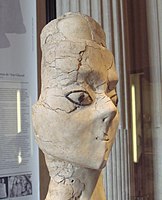அயின் காஜல் சிலைகள்

| செய்பொருள் | சுண்ணாம்புக் கல் கலவை, நாணல் புல் & லினன் துணிகள் |
|---|---|
| அளவு | 32 |
| உருவாக்கம் | கிமு 7200 [1] - கிமு 6200 [2] |
| தற்போதைய இடம் | ஜோர்தான் அருங்காட்சியகம் |
அயின் காஜல் சிலைகள் ( Ain Ghazal Statues), பண்டைய அண்மை கிழக்கு பிரதேசத்தில் மேல் மெசொப்பொத்தேமியாவின் தற்கால ஜோர்தான் நாட்டின் தலைநகரமான அம்மான் நகரத்திற்கு அருகில் அயின் காஜல் எனும் தொல்லியல் களத்தில், மட்பாண்டத்திற்கு முந்தைய புதிய கற்காலத்தின் கிமு 7,200 – கிமு 6,200-க்கு இடைப்பட்ட காலப்பகுதியில், சுண்ணாம்புக் கல் கலவை மற்றும் நாணல் புல்லினால் செய்து நிறுவப்பட்ட 15 சிலைகளின் தொகுதியாகும். அயின் காஜல் பகுதியில் 1983 மற்றும் 1985 ஆண்டுகளில் மேற்கொண்ட தொல்லியல் அகழ்வாய்வுகளில் இத்தொன்மை வாய்ந்த சிலைகள் கண்டுபிடிக்கப்பட்டது.[3]
தொல்லியல் அறிஞர்கள், அயின் காஜல் சிலைகளின் காலம், கிமு ஏழாயிரமாண்டின் நடுப்பகுதிக்கும், கிமு எட்டாயிரமாண்டின் நடுப்பகுதிக்கும் இடைப்பட்ட காலம் எனக்கணித்துள்ளனர்.[2]அயின் காஜல் சிலைகள் மேல் மெசொப்பொத்தேமியாவின் வரலாற்றுக்காலத்திற்கு முந்தைய, மட்பாண்டத்திற்கு முந்தைய புதிய கற்காலக் கலைகளை எடுத்துரைக்கிறது.
அயின் காஜல் சிலைகளில் பெரியது 1 மீட்டர் உயரமும், சிறியது 20 செண்டி மீட்டர் உயரமும் கொண்டுள்ளது.[4][5][6][7]அயின் காஜல் சிலைகளில் சிலவற்றவை தற்போது ஜோர்தான் அருங்காட்சியகத்திலும், லூவர் அருங்காட்சியகத்திலும் காட்சிக்கு வைக்கப்பட்டுள்ளது.

அயின் காஜல் சிலைகள் ( Ain Ghazal Statues), பண்டைய அண்மை கிழக்கு பிரதேசத்தில் மேல் மெசொப்பொத்தேமியாவின் தற்கால ஜோர்தான் நாட்டின் தலைநகரமான அம்மான் நகரத்திற்கு அருகில் அயின் காஜல் எனும் தொல்லியல் களத்தில், மட்பாண்டத்திற்கு முந்தைய புதிய கற்காலத்தின் கிமு 7,200 – கிமு 6,200-க்கு இடைப்பட்ட காலப்பகுதியில், சுண்ணாம்புக் கல் கலவை மற்றும் நாணல் புல்லினால் செய்து நிறுவப்பட்ட 15 சிலைகளின் தொகுதியாகும். அயின் காஜல் பகுதியில் 1983 மற்றும் 1985 ஆண்டுகளில் மேற்கொண்ட தொல்லியல் அகழ்வாய்வுகளில் இத்தொன்மை வாய்ந்த சிலைகள் கண்டுபிடிக்கப்பட்டது.[8]
தொல்லியல் அறிஞர்கள், அயின் காஜல் சிலைகளின் காலம், கிமு ஏழாயிரமாண்டின் நடுப்பகுதிக்கும், கிமு எட்டாயிரமாண்டின் நடுப்பகுதிக்கும் இடைப்பட்ட காலம் எனக்கணித்துள்ளனர்.[2] அயின் காஜல் சிலைகள் மேல் மெசொப்பொத்தேமியாவின் வரலாற்றுக்காலத்திற்கு முந்தைய, மட்பாண்டத்திற்கு முந்தைய புதிய கற்காலக் கலைகளை எடுத்துரைக்கிறது.
படக்காட்சிகள்[தொகு]
-
அம்மான் அரண்மனையில் அயின் காஜல் சிலைகள்
-
அம்மான் அரண்மனையில் ஆயின் காஜல் சிலைகள்
-
அயின் காஜல் சிலை, லூவர் அருங்காட்சியகம்
-
அயின் காஜல் சிலை, லூவர் அருங்காட்சியகம்
-
அயின் காஜல் சிலை, லூவர் அருங்காட்சியகம்
-
அயின் சிலை, பிரித்தானிய அருங்காட்சியகம்
இதனையும் கான்ண்க[தொகு]
மேற்கோள்கள்[தொகு]
- ↑ Besim Ben-Nissan (17 April 2014). "Advances in Calcium Phosphate Biomaterials". Springer Science & Business. p. 436. பார்க்கப்பட்ட நாள் 5 July 2016.
- ↑ 2.0 2.1 2.2 Kleiner, Fred S.; Mamiya, Christin J. (2006). Gardner's Art Through the Ages: The Western Perspective: Volume 1 (Twelfth ). Belmont, California: Wadsworth Publishing. பக். 25. பன்னாட்டுத் தரப்புத்தக எண்:0-495-00479-0. https://archive.org/details/gardnersartthrou00unse. கிமு 6250
- ↑ ʿAin Ghazal, ARCHAEOLOGICAL SITE, JORDAN
- ↑ Chacon, Richard J.; Mendoza, Rubén G. (2017) (in en). Feast, Famine or Fighting?: Multiple Pathways to Social Complexity. Springer. பக். 120. பன்னாட்டுத் தரப்புத்தக எண்:9783319484020. https://books.google.com/books?id=zhT1DQAAQBAJ&pg=PA120.
- ↑ Schmidt, Klaus (2015) (in fr). Premier temple. Göbekli tepe (Le): Göbelki Tepe. CNRS Editions. பக். 291. பன்னாட்டுத் தரப்புத்தக எண்:9782271081872. https://books.google.com/books?id=M3yUDwAAQBAJ&pg=PT291.
- ↑ Collins, Andrew (2014) (in en). Gobekli Tepe: Genesis of the Gods: The Temple of the Watchers and the Discovery of Eden. Simon and Schuster. பக். 66. பன்னாட்டுத் தரப்புத்தக எண்:9781591438359. https://books.google.com/books?id=q1koDwAAQBAJ&pg=PT66.
- ↑ Feldman, Keffie. "Ain-Ghazal (Jordan) Pre-pottery Neolithic B Period pit of lime plaster human figures". Joukowsky Institute, Brown University. பார்க்கப்பட்ட நாள் 16 June 2018.
They are largely held to represent the ancestors of those in the community, or variations on this theme. One can make the argument for this based on the similar treatment of the heads of these statues and the disarticulated and buried plastered skulls. The burial of the statues is also similar to the manner in which the people of Ain Ghazal buried their dead. However, what if these statues are not representations at all, but instead are enlivened objects themselves? What if they were buried in a similar manner to humans because they were thought to have died, or have lost their animate powers? These statues bring up equally many questions as answers, and for this reason will provide a rich site for future study.
- ↑ ʿAin Ghazal, ARCHAEOLOGICAL SITE, JORDAN
- Akkermans, Peter M.M.G. and Glenn M. Schwartz (2003), The archaeology of Syria: from complex hunter-gatherers to early urban societies (ca. 16,000-300 BC), Cambridge World Archaeology, Cambridge University Press, pp. 83ff.
- Grissom, C.A. (2000), "Neolithic statues from 'Ain Ghazal: construction and form", American Journal of Archaeology 104, 25-45.
- Rollefson, G.O. (1983), "Ritual and ceremony at Neolithic 'Ain Ghazal (Jordan)". Paleorient 9, 29-38.
- Rollefson, G.O. (1984), "Early Neolithic statuary from 'Ain Ghazal (Jordan)", Mitteilungen der Deutschen Orient-Gesellschaft 116, 185-192.
- Rollefson, G.O. (1986), "Neolithic 'Ain Ghazal (Jordan)- Ritual and ceremony II", Paleorient 12, 45-51.














